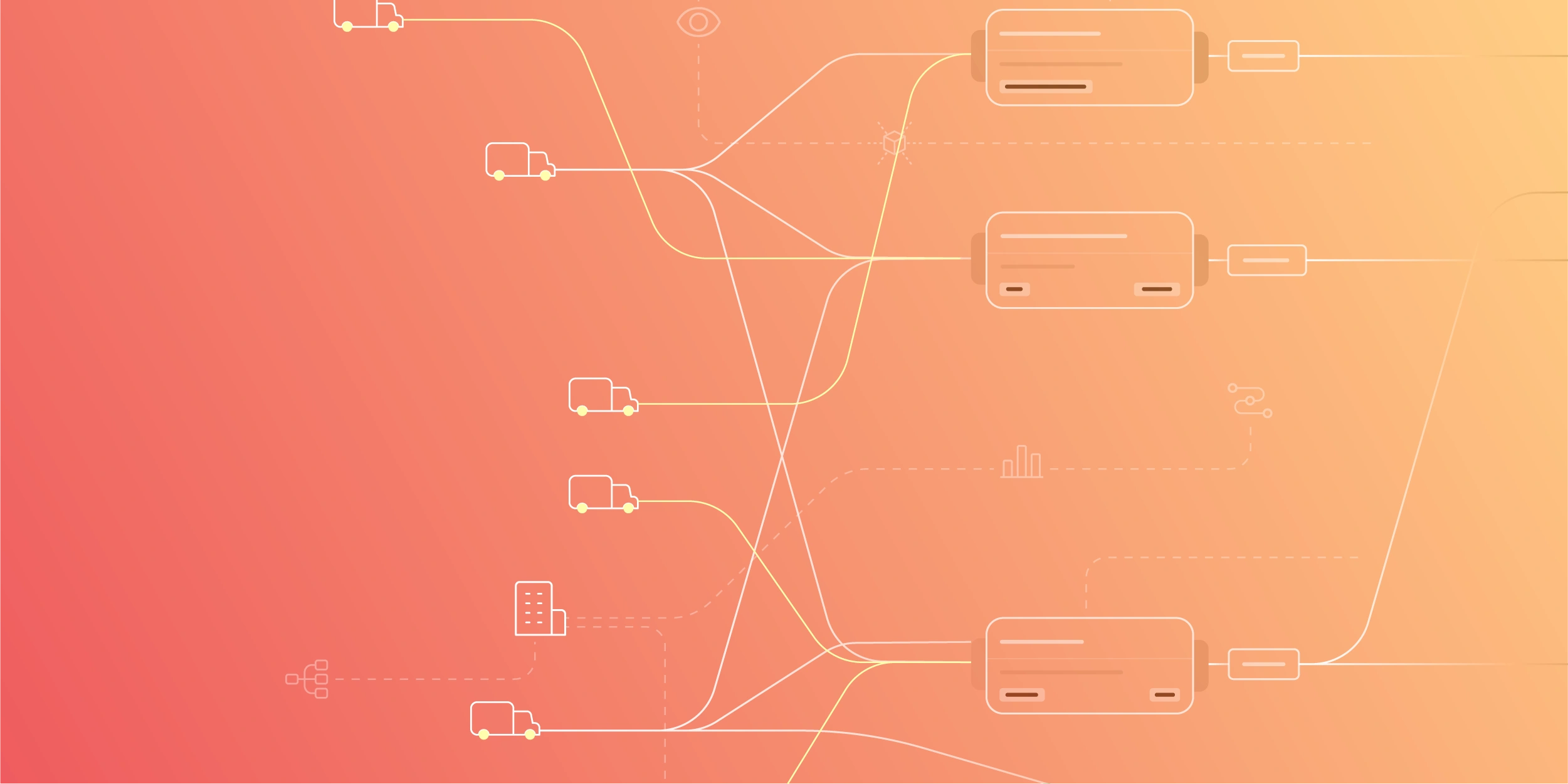Businesses have been adopting Artificial Intelligence (AI) to a great extent to keep up with their competition. As of 2023, more than 80% of global companies have reported adopting AI to improve their business operations.
Increased efficiency and automation are the driving forces that urge businesses to adopt AI. In fact, for 83% of these companies, AI takes the top spot in their business strategy, reshaping their operations and gaining a competitive advantage.
To better understand the growing adoption of AI, this article will delve into relevant trends, statistics, and market share of AI adoption in different businesses.
Editor’s Choice
- In 2019, AI adoption by companies peaked at 58%
- Different industries use 20% of each AI function.
- In the business sector, 35% of companies have reported using AI.
- Up to 26% of legal professionals use generative AI in law firms.
- 40% of retailers have adopted AI to enhance in-person experiences and implement real-time pricing.
- AI in finance achieved $9.45 billion in 2021 and is expected to grow at 16.5% by 2030.
- AI in Healthcare was valued at $15.4 billion; this value is expected to increase by a CAGR rate of 37.5% from 2023 to 2030.
- The global AI in telecommunications was valued at $1.45 billion in 2022.
An In-depth Look at Research and Studies on the Adoption of AI Solutions of Companies
In 2017, McKinsey reported that 20% of companies adopted AI in their product offerings and business operations. This data has doubled its value in the past years; in 2019, it peaked at 58% adoption.
Recent 2022 results show that AI adoption and usage have flattened out and stabilized after rapid growth from 2020 to 2022, in the 50-56% range.
Here is a closer look at the percentage of companies adopting AI in at least one business function since 2017:
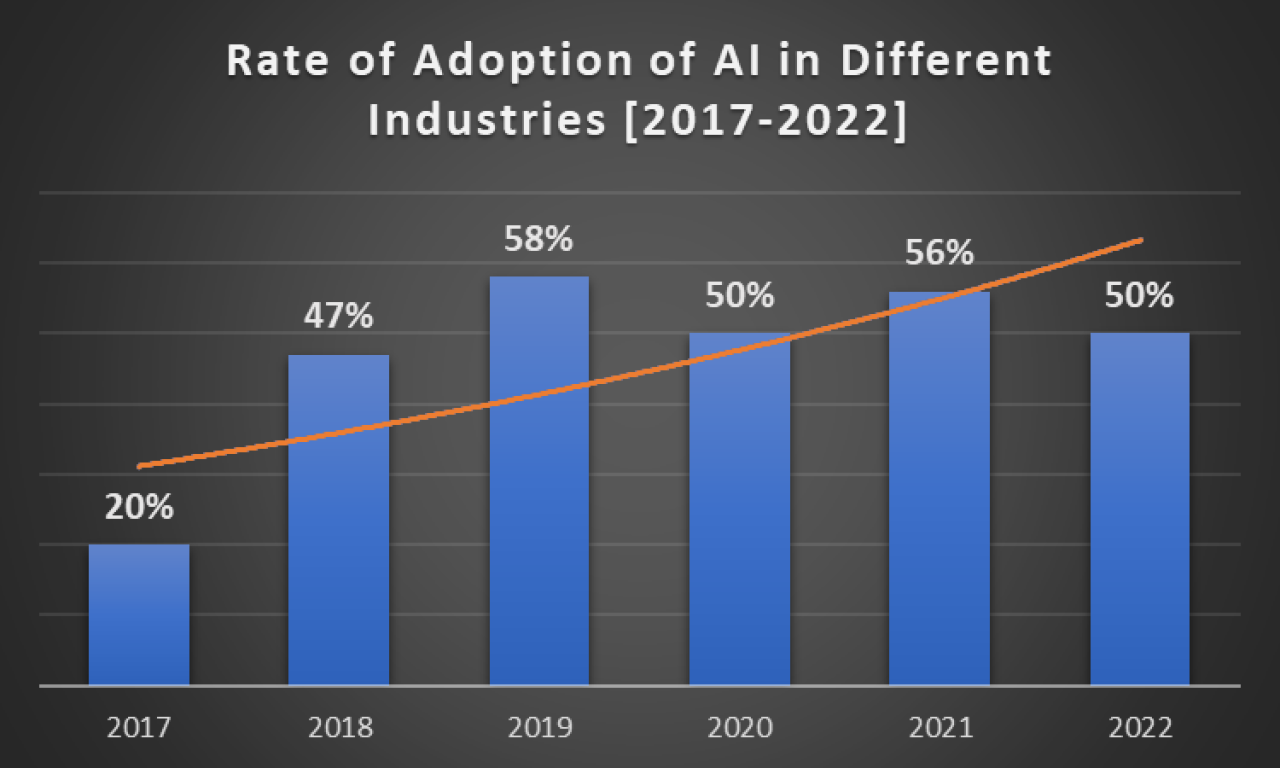
The need to implement a strategy that can apply AI to business goals is why AI adoption has been gradual up to this point. Moreover, companies are facing five barriers:
| Barriers | Percentage |
|---|---|
| Limited AI skills, expertise or knowledge | 34% |
| The price is too high | 29% |
| Insufficient tools or platforms to develop models | 25% |
| Projects are too difficult or complex to integrate and scale | 24% |
| Too much data complexity | 24% |
Compared to larger companies that have already established their strategy, many organizations – particularly smaller ones – still need to embrace AI and work to develop the right strategies.
To understand AI’s transformative role in different industries, the adoption rate growth for the past years, and how it is integrated by companies and the leading companies using AI, read the following section.
AI Adoption by Companies per Industry
AI has become so prominent in helping businesses, and the rise of generative AI like ChatGPT, DALL-E, and Bard has contributed to the growing adoption of AI in each industry.
A recent survey by Statista shows that all industries are reported to use 20% of each AI function. These industries’ usage of AI depends on their problems and the type of approach and technique they want to employ in their operations. The industry with the most significant usage of AI functions in product making in 2021 was the financial services industry, with over 30% of respondents.
Here’s an overview of the different industries using AI in their operations in various functions and approaches:

More industries are adopting AI due to its many capabilities when employed in their workforce. These companies are motivated by three factors, which include the following:
- the ability to cut expenses
- develop faster
- grow profitability
To better understand the trend of AI adoption according to its industry, read the following section.
1. AI adoption in business, legal, and professional services: 48.4% of businesses report measurable results.
(NewVantage Partners)
In the business sector, 35% of companies reported using AI, and 42% mentioned exploring AI. More than half of these organizations have developed a corporate data strategy yielding results.
Recent 2022 data by NewVantage Partners show that 92.1% of these businesses experience significant increases compared to the 2017 data, with 48.4% measurable results.
| Respondents Yielding Measurable Results in Adopting AI | 2017 | 2020 | 2022 |
|---|---|---|---|
| Yes | 48.4% | 70.3% | 92.1% |
| No | 51.6% | 29.7% | 7.9% |
The Advantages of Leveraging AI in Businesses: Business leaders Observed Productivity by 44%.
AI is helping businesses address labor and skills shortages by automating repetitive tasks. 28% of business leaders use AI to save costs, leverage automation, and improve business efficiency.
Business leaders saw a 44% increase in productivity through adopting AI in their operations. Other benefits include the following:
- improved decision-making
- enhanced customer experience
- innovative products and services
- developed employee skills and experiences
- new, data-driven business models
The Prominent Result of Adopting AI in Legal Services: 26% of Legal Services Adopting Generative AI.
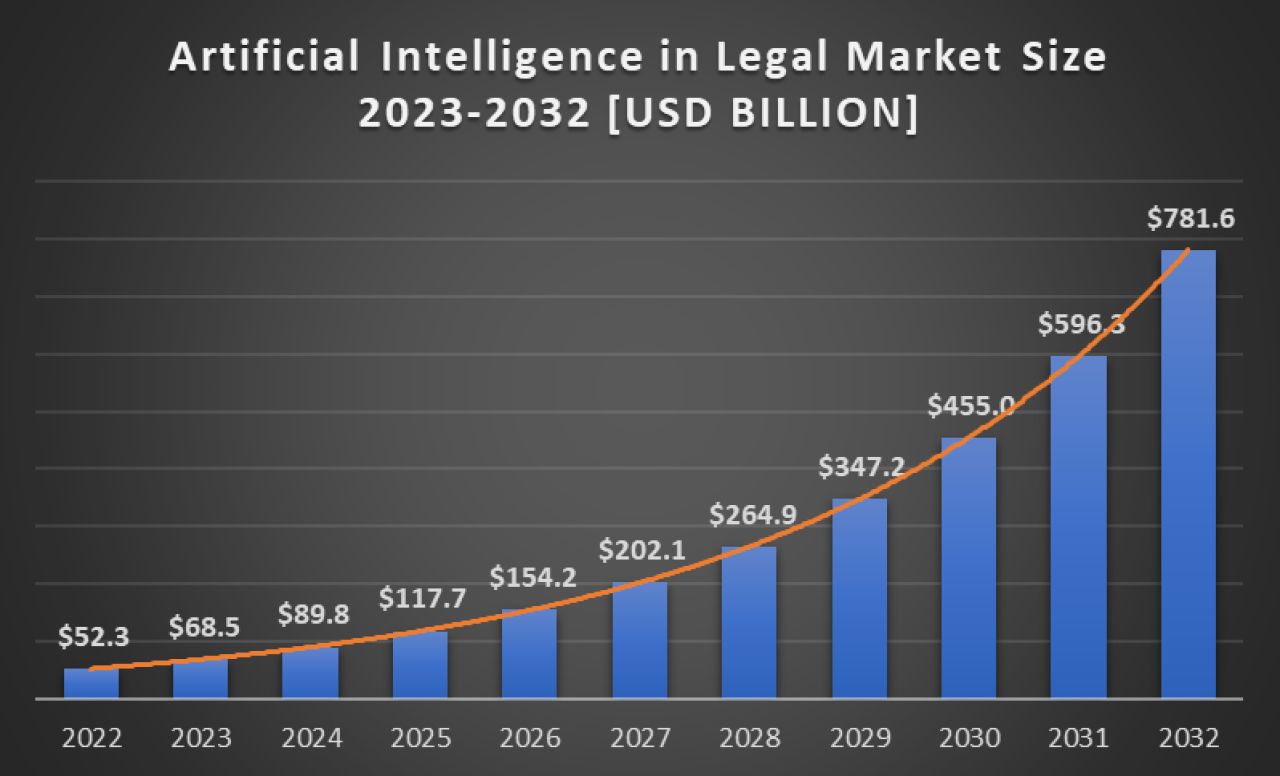
According to a new study from LexisNexis, Up to 26% of legal professionals now use generative AI in law firms more than once a month, a significant increase from 11% in the previous year.
Legal professionals were more likely to use generative AI tools every month if they worked at larger law forms (32%) or academic institutions (33%). Moreover, 42% plan to incorporate AI in their legal work, such as redlining and document automation.
Types of AI Technology Used in Legal Industry: Redlining Most Used With 98% Adoption.
Based on the Technology Survey published by ILTA, the International Legal Technology Association, redlining is the top technology legal professionals adopt, with over 97% of respondents, followed by document automation with 78%.
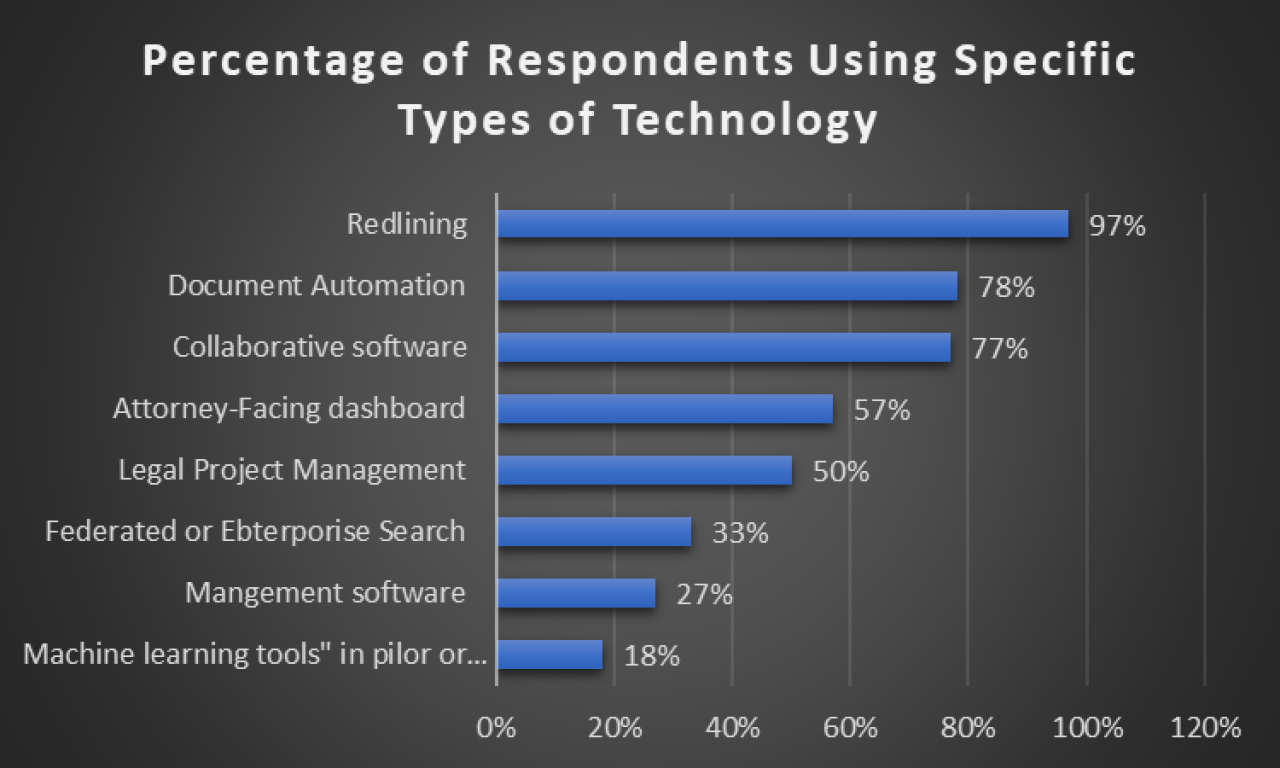
Here’s a list of the top 10 AI tools legal professionals use to streamline day-to-day tasks and draft complex legal documents and contracts:
- Casetext
- AILawyer
- ChatGPT
- Relativity
- LawGeex
- Everlaw
- LegalRobot
- Harveyai
- Lex Machina
- Latch
2. AI Adoption Rate in Consumer Goods/Retail: Obtained 40% Adoption and Expected to Reach $45.74 Billion by 2032.
(Precedence Research)
The adoption of AI has influenced the retail industry. In this era where consumers are moving to online shopping, 40% of retailers have adopted AI to enhance in-person experiences and implement real-time pricing and customer research. This number is continuously growing and is expected to reach 80% by 2025.
Precedence Research indicates that AI in retail market size is expected to reach $45.74 billion by 2032. From 2023 to 2032, it will have a compound annual growth rate of 18.45%.
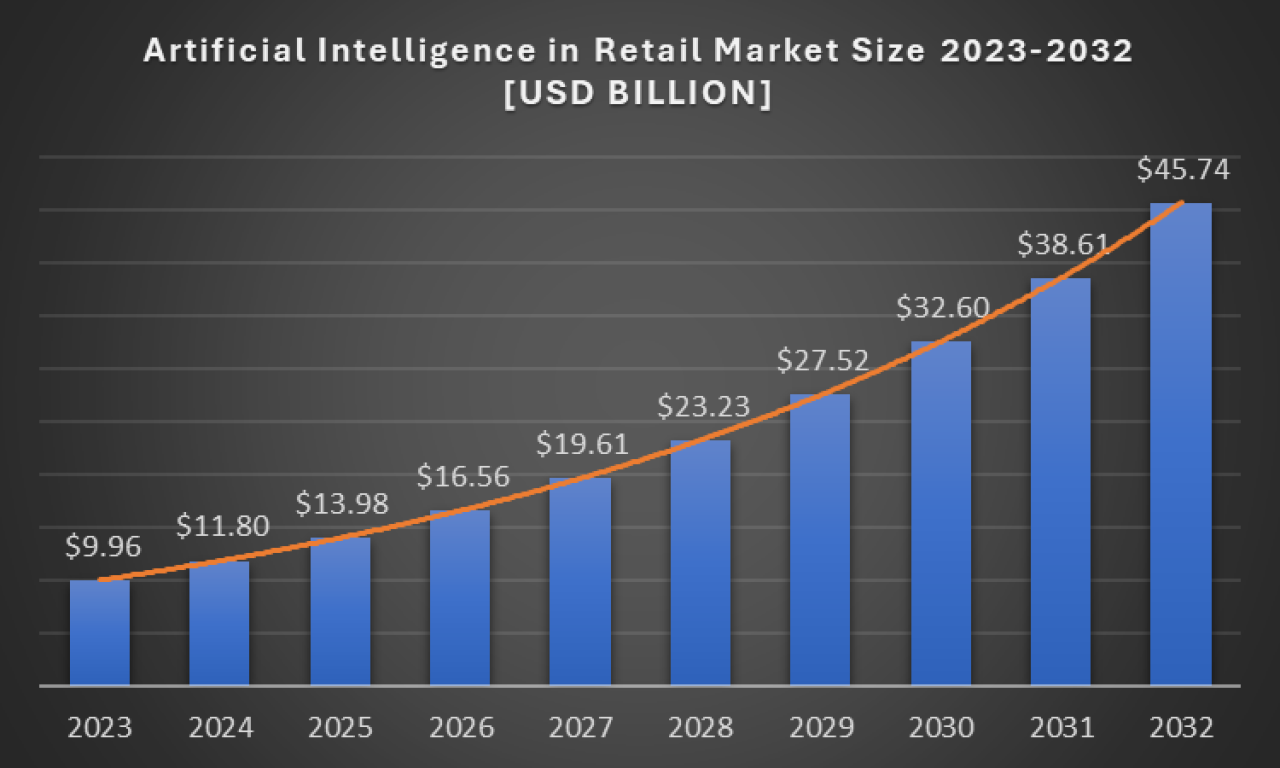
The adoption of AI in retail completely transformed the traditional retail experience, improved the retail market in all areas, and upgraded it to the next level. Through applying:
- Forecasting demand
- Hyper-personalization
- Supply chain logistics
- Inventory management
- CRM
How Companies Are Adopting AI in Retail Industry
To better understand how retail industries have leveraged and adopted AI into their business. The table below shows the best examples of using artificial intelligence for retail experiences.
| Companies | Type of AI Used |
|---|---|
| Sephora | User Color IQ and Lip IQ help consumers find the perfect makeup shade without ever putting anything on their face. |
| North Face | Utilizes IBM Watson’s cognitive technology to ask consumers questions and provide personalized recommendations for finding the perfect coat. |
| Taco Bell | Uses Tacobot, which is connected to Slack and allows customers to order tacos on the go. |
| Lowes | Created LoweBot to ensure and help customers find their way around the store and get the items they need. |
| Walgreens | Uses AI to track flu spread through data from several antiviral prescriptions filling more than 8,000 locations. |
| Walmart | Uses self-scanning robots that can scan missing items, tags that need changing, and things that need to be restocked. |
| Amazon | Employs the Amazon Go store, eliminating cashiers and creating a quick and seamless shopping experience for customers. |
3. Market Revenue for AI Adoption Rate in Financial Services Expected to Reach $9.48 Billion in 2032.
(MarketResearch.Biz)
The Generative AI in Financial Services Market reached a value of $0.85 Billion in 2022 and is expected to increase at a CAGR of 28.1% from 2022 to 2032, which is equivalent to $9.48 Billion, surpassing by a large margin the number in 2022.

The world of finance and baking meets new heights with the adoption of AI. It met demands and provided safer and more convenient ways to access, spend, and invest money.
AI technology can determine a customer’s typical behavior by monitoring their interactions and considering their transactions. It is widely used in financial organizations for the following reasons:
- fraud detection and prevention
- mobile banking
- digital loans
- insurance
- credit scores
- purchasing and selling operations
- asset management
Companies Using AI in Their Finance Operations
To grasp how AI is integrated into finance fully, here’s a list of the leading companies adopting AI Finance in their strategies and operations:
| Companies | How AI is Adopted in Finance |
|---|---|
| Kensho Technologies | Developed machine learning and data analytics software to assess multiple data sets and documents. |
| AlphaSense | Valuable to various financial professionals, organizations, and companies and especially helpful for brokers. |
| Enova | Uses machine learning and AI when integrating its lending platform to provide credit assessments to clients and advanced financial analytics. |
| Scienaptic | Offers several financial services. One example of how AI is adopted is through credit underwriting, which allows banks and credit institutions to cut losses and increase transparency. |
| Socure | The analysis of applicants’ social data, both online and offline, is what AI does best for this company. Its identity verification system and machine learning are top-notch. |
| Vectra AI | AI-powered cyber-threat detection platform that automates threat detection, reveals hidden attackers that explicitly target financial institutions, and accelerates investigations after incidents. |
4. The Adoption Rate of AI in Healthcare Increased Rapidly Due to COVID-19 and Was Valued at $15.4 Billion in 2022.
(Statista)
The adoption of AI in the healthcare industry has been evolving rapidly due to the urgency prompted by the COVID-19 pandemic. In 2022, AI in healthcare was valued at $15.4 billion; this value is expected to increase by a CAGR rate of 37.5% from 2023 to 2030.
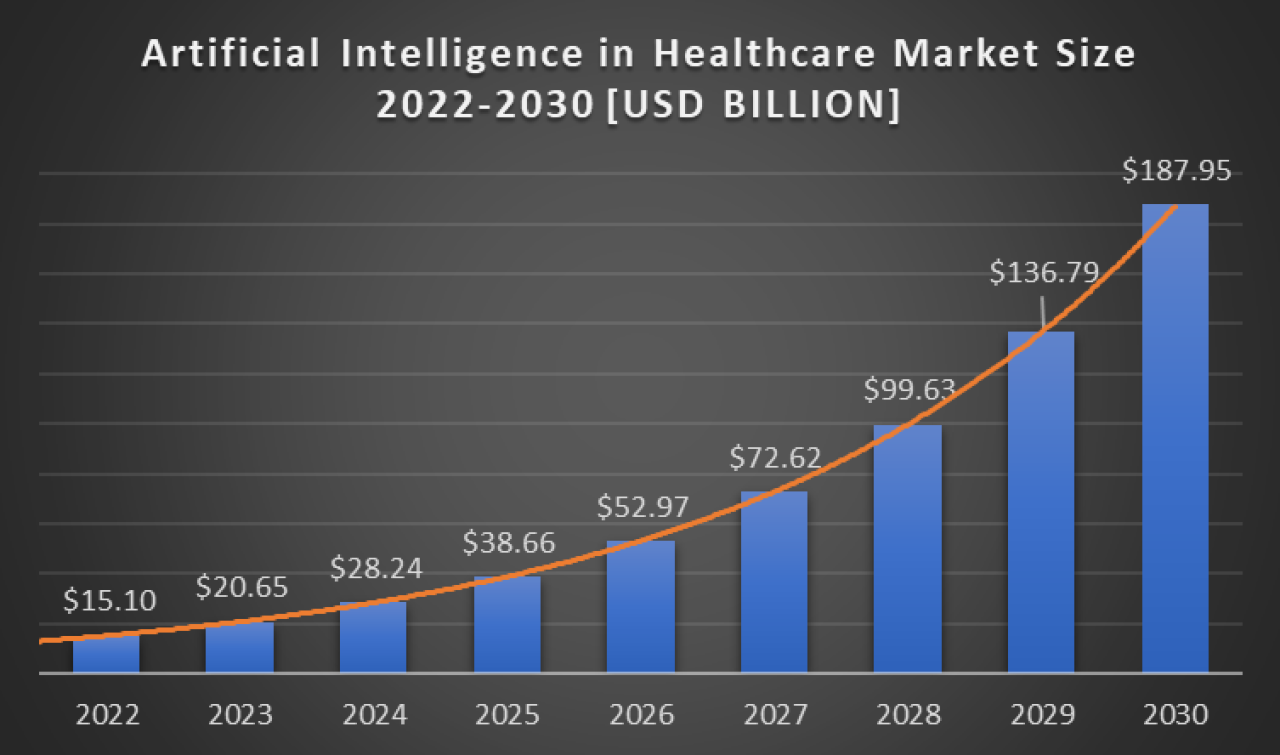
AI is aiding multiple fronts in healthcare, and the increasing demand for personalized care, medicine, and data sets has urged 15% of healthcare professionals to adopt AI.
Some of the impacts that increase convenience and efficiency cause this adoption rate to soar. These include the following:
- patient self-service
- chatbots
- computer-aided detection (CAD)
- image data analysis for drug discovery
The Rise of AI in Healthcare Companies
Adopting AI in healthcare introduces a more diverse and advanced drug discovery process and product development in many ways. Here are the ten companies adopting AI in healthcare:
| Companies | How AI is Adopted In Finance |
|---|---|
| Butterfly Network, Inc. | Obtained clearance using an AI-enabled Auto B-line counter that evaluates adults with suspected diminished lung function. Moreover, this company also uses ultrasound imaging solutions. |
| Exscientia Plc | Offers AI platforms for drug discovery and development. Its integration of AI through the platform includes drug identification, drug candidate design, translational models, and patient selection. |
| Relay Therapeutics | A clinical-stage precision medicines company offering drug discovery services. Its platform extensively uses AI and machine learning for drug discovery. |
| Certara, Inc. | Offers software products for biosimulation in drug discovery and preclinical and clinical research. AI accesses data, reviews, validates, and fine-tunes generated responses. |
| Humana Inc. | AI is used in its backend operations to optimize performance. It is also used for proactive care, ensuring “no one slips through the cracks” and that people requiring healthcare are spotted through AI systems before emergencies. |
5. AI adoption rate in High tech/Telecom is Valued at $1.45 billion in 2022.
(Statista)
The global AI in telecommunications was valued at $1.45 billion in 2022, and there is an expected CAGR growth of 18.2% from 2023 to 2030.
Telecommunications is a rapidly growing industry that uses AI. 52% of telecom enterprises have already deployed AI-powered chatbots to improve customer experience and network reliability.
Application Insights on Telecom Industries Adopting AI: Network Security Prominently Adopted and Integrated.
To understand the impact of AI by application, the telecom market has been segmented into 5; this includes the following.
- Customer Analytics: This segment has the largest revenue share, up to 28.2% in 2022. The growing demand for real-time customer behavioral insights has paved the way for this market growth.
- Network security: Cybersecurity has benefited enormously from AI. A study published in 2021 showed that among the AI-driven cyberattack techniques identified, 56% were demonstrated in the access and penetration phase.
- Virtual assistance: The segment is expected to achieve the fastest growth of 31.4% over the forecast period since customer service automation creates substantial savings for telecom companies.
- Preventive maintenance: AI has revolutionized the way telecom companies handle maintenance. Research within multiple sectors shows that AI-based predictive maintenance can boost and elevate availability by up to 20% while reducing inspection costs and annual maintenance fees by up to 25% and 10%.
- Network optimization: Telecom networks have become increasingly more complex with the introduction of 5G. AI plays a significant role in managing this complexity.
Conclusion
The adoption of AI in different industries has reached a critical milestone. Over half of these companies have leveraged AI to optimize operations, develop innovations, and gain significant results. With these prominent results, AI’s potential and the advancement of technology can leverage and improve every industry in the coming years.
FAQs Companies’ AI Adoption Rates
What percentage of companies adopt AI?
More than 80% of companies have been adopting AI to boost efficiency in their operations.
What is the adoption rate for AI business?
Approximately 35% of businesses adopted AI in 2022, with a 4% growth from 2021. The growth rate is expected to be even more significant by the end of 2023.
Which industries are adopting AI the most?
The financial services industries have become the most significant global early adopters of AI solutions.
Which company is using AI the most?
Amazon is the leading user of AI, which integrates AI in e-commerce, cloud computing, logistics, and more.




